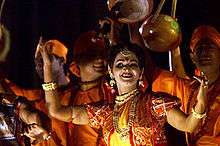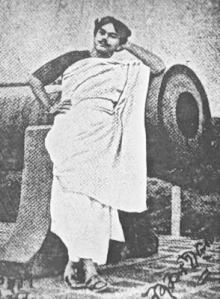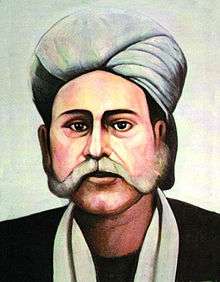Music of Bangladesh
Bangladesh claims some of the most renowned singers, composers and producers in South Asia. Bangladeshi music spans a wide variety of styles. Music has served the purpose of documenting the lives of the people and was widely patronized by the rulers. It comprises a long tradition of religious and regular song-writing over a period of almost a millennium.
| Music of Bangladesh | |
|---|---|
 | |
| Genres | |
| Specific forms | |
| Religious music | |
| Ethnic music | |
| Traditional music | |
| Media and performance | |
| Music awards | |
| Music festivals | |
| Music media | Radio
Television Internet |
| Nationalistic and patriotic songs | |
| National anthem | Amar Shonar Bangla |
| Other | Notuner Gaan (National March) Ekusher Gaan (Ode to the Language Movement) |
| Regional music | |
| Related areas | |
| Other regions | |
| Part of a series on the |
| Culture of Bangladesh |
|---|
 |
| History |
| Traditions |
|
Festivals
|
| Religion |
|
Genres Institutions Awards |
|
Music and performing arts Theatre People |
|
Media
|
| Sport |
|
Monuments |
|
Classical music

Ragapradhan Gaan
Bangladeshi classical music is based on modes called ragas. In composing these songs, the melodies of north Indian ragas are used. As far as the Charyagiti (9th century), ragas have been used in Bengali music. Jaydev’s Gitagovindam, Padavali Kirtan, Mangal Giti, Shyamasangit, Tappa, Brahma Sangeet and Tagore songs have been inspired by Ragas. The use of north Indian ragas in Bangla songs began in 18th century.[1] This trend gathered momentum during the 19th and 20th centuries. The pioneers of these trend were Ramnidhi Gupta, Kali Mirza, Raghunath Roy and the founder of the Bishnupur Gharana, Ramshanker Bhattacharya.[2] Nawab of Lakhnau, Wajid Ali Shah played an important role in this trend. He was dethroned by the British empire in 1856 and banished to Metiaburuz, Kolkata. During his 30-year exile, he patronized music, specially dhrupad, tappa, thumri and kheyal. And, thus made a lasting impact on Bangladeshi music.[3] All traditional Bengali music tend to be based on various variations of Hindustani Classical Music. Rabindranath Tagore had a deep appreciation for north Indian ragas, successfully introduced ragas in his songs. He was followed by Dwijendralal Roy, Rajanikanta Sen and Atulprasad Sen.[4][5][6][7]
Folk music

Folk has come to occupy the lives of Bangladeshis almost more than any other genre of Bengali music. Among the luminaries of the different folk traditions are Lalon Fokir, Shah Abdul Karim, Radharaman Dutta, Hason Raja, Khursheed Nurali (Sheerazi), Ramesh Shil, Kari Amir Uddin Ahmed and Abbas Uddin. Folk songs are characterised by simple musical structure and words. Before the advent of radio, entertainment in the rural areas relied on a large extent on stage performances by folk singers. With the arrival of new communication technologies and digital media, many folk songs were modernised and incorporated into modern songs (Adhunik songeet).
Folk music can be classified into several subgenres:
- Baul: mainly inspired by Lalon and almost exclusively performed by Baul mystics.
- Bhandari: Devotional music from the South (mainly Chittagong).
- Bhatiali: Music of fishermen and boatman, almost always tied by a common ragas sung solo.
- Bhawaiya: Song of bullock-cart drivers of the North (Rangpur).
- Dhamail: A form of folk music and dance originated in Sylhet. It is practiced in the Sylhet Division in Bangladesh and in areas influenced by the Sylheti culture such as the Barak Valley of Assam and parts of Tripura, Meghalaya and Manipur in India.
- Gazir Gaan: Devotional songs dedicated to Gazi Pir, who is part of Pach Pir tradition of folk practice and belief.[8]
- Ghazal: Popular folk music of Sufi genres, introduced from philosophy and religion in music practiced mainly by Bengali Muslims.
- Gombhira: Song (originated in Chapai Nawabganj) performed with a particular distinctive rhythm and dance with two performers, always personifying a man and his grand father, discussing a topic to raise social awareness.
- Hason Raja: Devotional songs written by a music composer by the name of Hason Raja (from Sylhet, northeastern side of Bangladesh near Assam) that was recently repopularised as dance music.
- Jari: songs involving musical battle between two groups
- Jatra Pala: songs associated exclusively with plays (performed on-stage). Usually involves colourful presentations of historical themes.
- Jhumur: traditional dance song form Bangladesh and eastern part of India.[9]
- Kavigan: poems sung with simple music usually presented on stage as a musical battle between poets.
- Kirtan: devotional song depicting love to Hindu God Krishna and his (best-known) wife, Radha.
- Lalon: best known of all folk songs and the most important subgenre of Baul songs, almost entirely attributed to spiritual writer and composer, Lalon Fokir of Kushtia. He is known to all in West Bengal of India too.(Western Bangladesh, near the border with West Bengal).
- Pala Gaan: folk ballad also known as Pat.[10]
- Sari: sung especially by boatmen. It is often known as workmen's song as well.
- Shyama Sangeet: a genre of Bengali devotional songs dedicated to the Hindu goddess Shyama or Kali which is a form of supreme universal mother-goddess Durga or parvati. It is also known as Shaktagiti or Durgastuti.[11]
Baul
Baul is the most commonly known category of Bangladeshi folk songs. It is mostly performed by hermits who are followers of Sufism in Bangladesh. Present day Sufis earn mainly from performing their music. Baul songs incorporate simple words expressing songs with deeper meanings involving creation, society, lifestyle and human emotions. The songs are performed with very little musical support to the main carrier, the vocal. Instruments used include the Ektara ("one-string"), Dotara ("two-strings"), ba(n)shi (country flute made from bamboo) and cymbals. In recent times, Baul geeti has lost popularity, due to urbanisation and westernisation.
রবীন্দ্র সঙ্গীত (Music of Robindra)
Rabindra Sangeet (Bengali: রবীন্দ্রসঙ্গীত Robindro shonggit, Bengali pronunciation: [ɾobindɾo ʃoŋɡit]), also known as Tagore Songs, are songs written and composed by Rabindranath Tagore. They have distinctive characteristics in the music of Bengal, popular in India and Bangladesh.[12] "Sangeet" means music, "Rabindra Sangeet" means Songs of Rabindra.
Rabindra Sangeet used Indian classical music and traditional folk music as sources.[13]
নজরুল গীতি (Music of Nazrul)
Nazrul Geeti or Nazrul Sangeet, literally "music of Nazrul," are songs written and composed by Kazi Nazrul Islam, a Bengali poet and national poet of Bangladesh and active revolutionary during the Indian Independence Movement. Nazrul Sangeet incorporate revolutionary notions as well as more spiritual, philosophical and romantic themes.
শাহ আবদুল করিম (Music of Shah Abdul Karim)
Shah Abdul Karim known as "Baul Samrat" or king of baul music, he has composed over 1600 baul songs, some of his notable songs include Keno Piriti Baraila Re Bondhu, Murshid Dhono He Kemone Chinibo Tomare, Nao Banailo Banailo Re Kon Mestori, Ashi Bole Gelo Bondhu and Mon Mojale Ore Bawla Gaan. He referred to his compositions as Baul Gaan. He holds voice against unfairness, injustice, prejudice and communalism through his writings. Karim portraits Bhati area’s people love, wish and happiness amid the writings. He got inspiration from another legendary musician Fakir Lalon Shah. Karim wrote many spiritual songs including Marfati or Dehatatta. Bangla Academy has translated ten songs of his in the English language. Karim wrote many spiritual songs including Marfati or Dehatatta. Bangla Academy has translated ten songs of his in English.
লালন গীতি (Music of Lalon)
Lalon also known as Fakir Lalon Shah, Lalon Shah, Lalon Fakir. Lalon composed numerous songs and poems, which describe his philosophy. Lalon left no written copies of his songs, which were transmitted orally and only later transcribed by his followers. Also, most of his followers could not read or write either, so few of his songs are found in written form.
Modern Bangla music
Adhunik sangeet literally means "modern songs". Although to outsiders, this may seem like an ambiguous nomenclature, it has particular motivations.
Bengali music traditionally has been classified mainly by the region of origin and the creators of the musical genre, such as Nazrul geeti (written and composed by Kazi Nazrul Islam), ghombhira (unique to a specific area in Bangladesh), etc. However, this prevented the ability to classify any music that failed to fit into any of the classes. In the period just before Indian independence, several new minor musical genres emerged, mainly in the form of playback songs for movies. A miscellaneous category, Adhunik sangeet, was created, since, at that time, this music was "modern".
Popular music
Modernisation of Bengali music occurred at different times and, for the most part, independent of western influence. Most notable of these changes were:
Pop music
The pop music of Bangladesh known as B-pop. It started from the 1970s. It was introduced in 1972 by singer, songwriter, music composer Nasir Ahmed Apu of Spondan band, pioneer of Bengali pop/rock and re-invented Bengali folk music in Bangladesh. Spondan was founded in Dhaka, Bangladesh on 17 January 1972. Spondan is the first band of Bangladesh. Feedback was formed in 1977, they were a cover band, they played in Hotel Intrercon for ten years from 1987 they started to perform as a bangla pop rock band. The 1990s is called 'The Golden Age of bangali music'. Because in 1990s century there are many notable bands like Souls, Feedback, Miles, Nagar Baul, Warfaze, RockStrata, LRB and Ark became popular for their songs.
Film music
The film industry of Bangladesh supported music by according reverence to classical music while utilizing the western orchestration to support melodies.
deshi rock music
Bangladeshi rock was introduced in 1972 by singer, songwriter, music composer Nasir Ahmed Apu of Spondan band, pioneer of Bengali pop/rock and re-invented Bengali folk music in Bangladesh. Spondan was founded in Dhaka, Bangladesh on 17 January 1972. Spondan's " Emom Ekta Ma Deana ', " Sritiro Shai pote ajo " songs written, tune and music by Nasir Ahmed Apu, Vocal by Ferdous Wahid, Record label Bangladesh Gramophone company, 1975 are all time hit. Other popular songs created by Nasir Ahmed Apu of Spondan are "Paglar mon Nacchaya", (Vocal by Ferdous Wahid, record label- Dhaka Record, 1974) "Ai Montare Daana mele diechi vocal by Nasir Ahmed Apu (recorded in 1974), Shajiey gujie de more (recorded in 1976) and further more. Uccharon was formed in 1973 and their first released album was "Ore Saleka, and High court er Majhare" vocal by Azam Khan of Uccharon, record label Dhaka Record, 1973. Subsequently, other contributory bands are Souls, Miles, Nagar Baul, Warfaze, RockStrata, LRB and Ark.
1990 || blue birds formed in chittagong first girls band of Bangladesh. their album name was saikat e ekdin 2010 || Bisharjan || Dhaka
| Formed | Name | Genre | Language | City of origin |
|---|---|---|---|---|
| 1973 | Souls | Pop/Rock | Bengali | Chittagong |
| Uccharon | Dhaka | |||
| 1972 | Spondan | |||
| 1976 | Feedback | Rock music | ||
| 1978 | Miles | Pop/Rock | ||
| 1980 | Nagar Baul | Hard rock, psychedelic rock | Chittagong | |
| 1980s | Different Touch | Pop/Rock | Khulna | |
| 1984 | Warfaze | Hard rock, heavy metal music | Chittagong | |
| 1985 | Rockstrata | Heavy Metal | Dhaka | |
| 1986 | Nova | Rock music, Hard rock, Psychedelic rock | ||
| 1991 | Love Runs Blind | Alternative rock | Chittagong | |
| Ark | Pop rock | |||
| 1993 | Cryptic Fate | Progressive metal | Dhaka | |
| 1996 | Shironamhin | Folk music, alternative rock, psychedelic rock | ||
| Dalchhut | Rock music | |||
| 1998 | Aurthohin | Rock music, Heavy Metal | ||
| Black | Rock music, alternative rock, grunge | |||
| Poizon Green | Thrash/Power Metal | English | ||
| 1999 | Artcell | Progressive metal, progressive rock | Bangla | |
| Scarecrow | Thrash Metal, metal core | |||
| Nemesis | Alternative rock | |||
| 2000 | Lalon | Rock | ||
| 2001 | Stentorian | Hard rock, heavy metal | ||
| Vibe | Heavy Metal | |||
| Satanik | Black Metal | English | ||
| 2002 | Arbovirus | Experimental music, alternative rock, Nu metal | Bangla | |
| 2004 | Severe Dementia | Death Metal | English | |
| Funeral Anthem | Power Metal | Bangla | ||
| 2005 | Shohortoli | Theatrical rock | ||
| 2006 | De-illumination | Symphonic rock, symphonic metal | ||
| Mechanix | Heavy Metal | |||
| Powersurge | Thrash Metal | |||
| 2007 | Shunno | Pop rock | ||
| Tribe | Acid Rock/Metal | |||
| Bishorgo | Rock | Chittagong | ||
| Sent Men Revolt | Spiritual Thrash, Thrash, Heavy Metal | Dhaka | ||
| GrooveTrap[14][15] | Funk, R&B, Soul | English | ||
Fusion
Fusion, traditional music with Western instrumentation to revitalize and re-popularize Bengali music. Joler Gaan and Lampost are one of the best popular Fusion bands in Bangladesh. A new growing genre of Bangladesh music is contemporary urban music. The Bangla Youth Project by DJ AKS was one of the first Urban Bangla, RnB/Pop Music album in 2010. Most of the songs contained English and Bengali lyrics. Contemporary Urban music got popularity with the introduction of American and British television channels and Hollywood movies. Recently, there has been an 'Urban Bangla' scene growing in North America, Australia, and in particular the Asian Underground in the United Kingdom where there is also fusion going on between Sylheti music as well. Notable Urban Bangla artists include DJ AKS, Master-D, Shahrar Nizam, Stoic Bliss, Iksy, Char Avell, Bilal Shahid, Fuad, Mumzy Stranger, Redz & Ashboii, Muza and Nish.
Instruments

Common instruments are:
- Sitar
- Violin
- Flutes
- Harmonium
- Esraj (a traditional Bengali instrument)
- Ektara ("one-string")
- Dotara ("two-strings")
- Khamak
- Dhak
- Dhol
See also
References
- "Traditional Music of Bangladesh". www.travelspedia.com. Retrieved 21 January 2019.
- "Classical Music of Bengal". www.onlineradiobox.com. Retrieved 21 January 2019.
- "New Horizons of Bangladeshi Classical Music". www.thedailystar.net. Retrieved 20 January 2019.
- "Bangla Classical Music Festival". www.banglaclassicalmusicfest.com. Retrieved 20 January 2019.
- "Classical music of Bangladesh". en.banglapedi.org. Retrieved 19 January 2019.
- "Music of Bangladesh". www.dhakaholidays.com. Retrieved 20 January 2019.
- "History of Bangladeshi Music". www.scribd.com. Retrieved 21 January 2019.
- "Gazir Gaan: Representation of tolerance and social equality". thedailystar.net. 14 April 2015. Retrieved 21 March 2018.
- "Jhumur Song - Banglapedia". en.banglapedia.org. Retrieved 21 March 2018.
- "Pala Gan - Banglapedia". en.banglapedia.org. Retrieved 21 March 2018.
- Sayeed, Khan Md (2012). "Shyamasangit". In Islam, Sirajul; Jamal, Ahmed A. (eds.). Banglapedia: National Encyclopedia of Bangladesh (Second ed.). Asiatic Society of Bangladesh.
- Ghosh, p. xiii
- Huke, Robert E. (2009). "West Bengal". Encyclopædia Britannica. Encyclopædia Britannica Online. Retrieved 2009-10-06.
- "Jasper al-Rashid". The Daily Star. 31 August 2018. Retrieved 2018-09-08.
- "Groovetrap Bringing the funk back after 10 years". The Daily Star. 19 August 2018. Retrieved 2018-09-08.